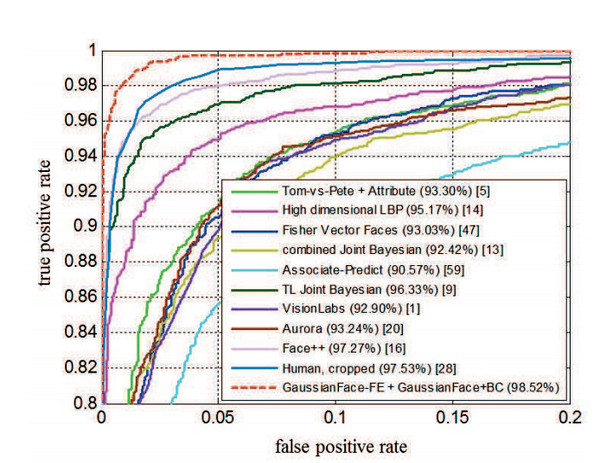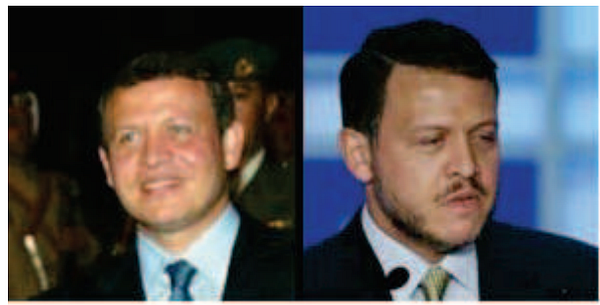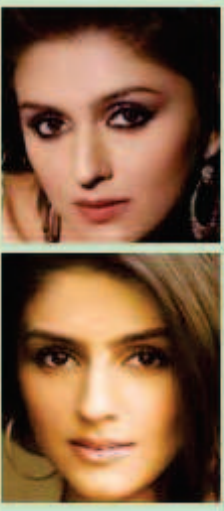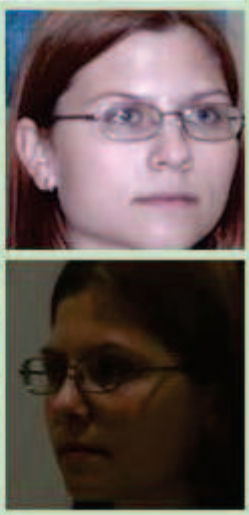人脸识别算法准确率最终超过了人类 The Face Recognition Algorithm That Finally Outperforms Humans
Everybody has had the experience of not recognising someone they know—changes in pose, illumination and expression all make the task tricky. So it’s not surprising that computer vision systems have similar problems. Indeed, no computer vision system matches human performance despite years of work by computer scientists all over the world.
That’s not to say that face recognition systems are poor. Far from it. The best systems can beat human performance in ideal conditions. But their performance drops dramatically as conditions get worse. So computer scientists would dearly love to develop an algorithm that can take the crown in the most challenging conditions too.
Today, Chaochao Lu and Xiaoou Tang at the Chinese University of Hong Kong say they’ve done just that. These guys have developed a face recognition algorithm called GaussianFace that outperforms humans for the first time.
The new system could finally make human-level face verification available in applications ranging from smart phone and computer game log-ons to security and passport control.

The first task in any programme of automated face verification is to build a decent dataset to test the algorithm with. That requires images of a wide variety of faces with complex variations in pose, lighting and expression as well as race, ethnicity, age and gender. Then there is clothing, hair styles, make up and so on.
As luck would have it, there is just such a dataset, known as the Labelled Faces in the Wild benchmark. This consists of over 13,000 images of the faces of almost 6000 public figures collected off the web. Crucially, there is more than one image of each person in the database.
There are various other databases but the Labelled faces in the Wild is well known amongst computer scientists as a challenging benchmark.

The algorithm identified all of the image pairs here as matches. But can you tell which are correct and which are wrong? Answer below
The task in facial recognition is to compare two images and determine whether they show the same person. (Try identifying which of the image pairs shown here are correct matches.)
Humans can do this with an accuracy of 97.53 per cent on this database. But no algorithm has come close to matching this performance.
Until now. The new algorithm works by normalising each face into a 150 x 120 pixel image, by transforming it based on five image landmarks: the position of both eyes, the nose and the two corners of the mouth.

It then divides each image into overlapping patches of 25 x 25 pixels and describes each patch using a mathematical object known as a vector which captures its basic features. Having done that, the algorithm is ready to compare the images looking for similarities.
But first it needs to know what to look for. This is where the training data set comes in. The usual approach is to use a single dataset to train the algorithm and to use a sample of images from the same dataset to test the algorithm on.

But when the algorithm is faced with images that are entirely different from the training set, it often fails. “When the [image] distribution changes, these methods may suffer a large performance drop,” say Chaochao and Xiaoou.

Instead, they’ve trained GaussianFace on four entirely different datasets with very different images. For example, one of these datasets is known as the Multi-PIE database and consists of face images of 337 subjects from 15 different viewpoints under 19 different conditions of illumination taken in four photo sessions. Another is a database called Life Photos which contains about 10 images of 400 different people.

Having trained the algorithm on these datasets, they finally let it loose on the Labelled Faces in the Wild database. The goal is to identify matched pairs and to spot mismatched pairs too.
Remember that humans can do this with an accuracy of 97.53 per cent. “Our GaussianFace model can improve the accuracy to 98.52%, which for the first time beats the human-level performance,” say Chaochao and Xiaoou.

That’s an impressive result because of the wide variety of extreme conditions in these photos.

Chaochao and Xiaoou point out that there are many challenges ahead, however. Humans can use all kinds of additional cues to do this task, such as neck and shoulder configuration. “Surpassing the human-level performance may only be symbolically significant,” they say.
Another problem is the time it takes to train the new algorithm, the amount of memory it requires and the running time to identify matches. Some of that can be tackled by parallelising the algorithm and using a number of bespoke computer processing techniques.

Nevertheless, accurate automated face recognition is coming and on this evidence sooner rather than later.

Answer: the vertical image pairs are correct matches. The horizontal image pairs are mismatches that the algorithm got wrong
Ref: arxiv.org/abs/1404.3840 : Surpassing Human-Level Face Verification Performance on LFW with GaussianFace
Follow the Physics arXiv Blog on Twitter at @arxivblog, on Facebook and by hitting the Follow button below.
from: https://medium.com/the-physics-arxiv-blog/the-face-recognition-algorithm-that-finally-outperforms-humans-2c567adbf7fc#.nvqi6691o
人脸识别算法准确率最终超过了人类 The Face Recognition Algorithm That Finally Outperforms Humans的更多相关文章
- DeepID人脸识别算法之三代(转)
DeepID人脸识别算法之三代 转载请注明:http://blog.csdn.net/stdcoutzyx/article/details/42091205 DeepID,目前最强人脸识别算法,已经三 ...
- DeepID人脸识别算法之三代
DeepID人脸识别算法之三代 转载请注明:http://blog.csdn.net/stdcoutzyx/article/details/42091205 DeepID,眼下最强人脸识别算法.已经三 ...
- Eigenface与PCA人脸识别算法实验
简单的特征脸识别实验 实现特征脸的过程其实就是主成分分析(Principal Component Analysis,PCA)的一个过程.关于PCA的原理问题,它是一种数学降维的方法.是为了简化问题.在 ...
- 总结几个简单好用的Python人脸识别算法
原文连接:https://mp.weixin.qq.com/s/3BgDld9hILPLCIlyysZs6Q 哈喽,大家好. 今天给大家总结几个简单.好用的人脸识别算法. 人脸识别是计算机视觉中比较常 ...
- 基于MATLAB的人脸识别算法的研究
基于MATLAB的人脸识别算法的研究 作者:lee神 现如今机器视觉越来越盛行,从智能交通系统的车辆识别,车牌识别到交通标牌的识别:从智能手机的人脸识别的性别识别:如今无人驾驶汽车更是应用了大量的机器 ...
- opencv学习之路(40)、人脸识别算法——EigenFace、FisherFace、LBPH
一.人脸识别算法之特征脸方法(Eigenface) 1.原理介绍及数据收集 特征脸方法主要是基于PCA降维实现. 详细介绍和主要思想可以参考 http://blog.csdn.net/u0100066 ...
- Visual C++ 经典的人脸识别算法源代码
说明:VC++ 经典的人脸识别算法实例,提供人脸五官定位具体算法及两种实现流程. 点击下载
- arcface和Dlib人脸识别算法对比
我司最近要做和人脸识别相关的产品,原来使用的是其他的在线平台,识别率和识别速度很满意,但是随着量起来的话,成本也是越来越不能接受(目前该功能我们是免费给用户使用的),而且一旦我们的设备掉线了就无法使用 ...
- NET 调用人脸识别算法
以前有个OpenCV 移植版EMCV可以用作图像识别等 https://github.com/emgucv/emgucv 现在有各种接口 比如虹软SDK https://ai.arcsoft.com ...
随机推荐
- NEST.net Client For Elasticsearch简单应用
NEST.net Client For Elasticsearch简单应用 由于最近的一个项目中的搜索部分要用到 Elasticsearch 来实现搜索功能,苦于英文差及该方面的系统性资料不好找,在实 ...
- Careercup - Google面试题 - 6332750214725632
2014-05-06 10:18 题目链接 原题: Given a ,) (,) (,), (,) should be returned. Some suggest to use Interval T ...
- 关于EF查询的性能
现象:前台grid发送ajax请求,通过谷歌devtool发现“waiting”时间高达23s(1500条数据);可见服务器端代码处理花费时间很长: 解决:分析代码,有两处代码注释掉后速度提升明显 / ...
- 使用sqlserver日期函数获取当前日期
使用sqlserver日期函数中的getdate()可以获取当现的日期,下面就将为您介绍这种使用sqlserver日期函数获取当前日期的方法,供您参考,希望对您学习sqlserver日期函数有所启迪. ...
- python 循环技巧
原文地址:http://docs.pythontab.com/python/python3.4/datastructures.html#tut-tuples 在字典中循环时,关键字和对应的值可以使用 ...
- modernizr.js
1.判断浏览器是否支持 h5 if(Modernizr.canvas){ alert(123); }else{ alert(321); } 2.判断浏览器是否支持 canvas function su ...
- BZOJ2039 [2009国家集训队]employ人员雇佣
AC通道:http://www.lydsy.com/JudgeOnline/problem.php?id=2039 鉴于一开始看题如果不仔细是看不懂题目的,还是说一下题目大意 [题目大意]:给定n个人 ...
- File not found images\Thumbs.db.
启动eclipse正常,部署项目的时候发生这个错误. 解决办法: 1. 从tomcat中删除这个项目,并清空work目录下的缓存 2. 在eclipse中执行project>Clean>C ...
- UML状态图(转载)
概述: 图表本身的名称,阐明该图的目的和其他细节.它描述了在一个系统中的一个组成部分不同的状态.状态是特定的一个系统的组件/对象. 状态图描述了一个状态机.我们阐明的状态机可以被定义为一台机器,它定义 ...
- POJ 3258 River Hopscotch (binarysearch)
River Hopscotch Time Limit: 2000MS Memory Limit: 65536K Total Submissions: 5193 Accepted: 2260 Descr ...
